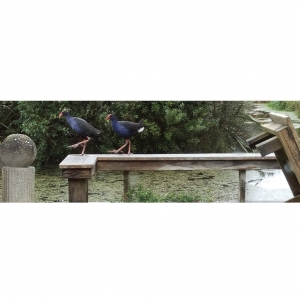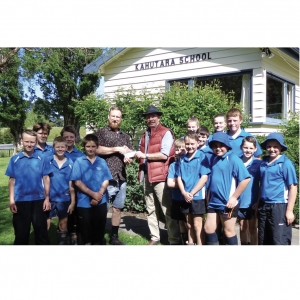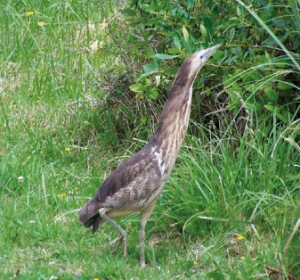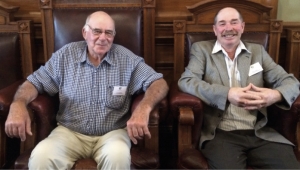Displaying items by tag: Wetlands
Weedbusting, Mahurangi River, Warkworth
Planting day at Ruffit Lodge
Fine weather was ideal for a ‘planting’ day at Ruffit Lodge (east of Woodville) mid May, with a few neighbours, friends and family mucking in to help.
160 trees were planted, with most getting the Don Bell ‘Growtector’ treatment. “This is the last section of our waterway to be fenced and planted. Just a few more flaxes and trees to go.” To encourage helpers Julie Candy offered soup and buns for lunch.
Wetlands of New Zealand
places that might interest you – especially the wild life.
Wetland importance is often under-rated. Groups like our own DU Wetland Care and the national wetlands Trust are working towards reversing this trend. There is a great diversity of wildlife in our wetlands with more native birds, fish, invertebrates and plants than most other habitats, yet many wetland species are threatened with extinction Wetlands have high recreational values, and perform vital ecosystem services such as improving water quality and reducing flood risks. They have a big role in managing climate change. Healthy peat bogs are year-round sinks of 2–5 tonnes of carbon per hectare – locking it up in their soil indefinitely.
Wetlands are of cultural and spiritual significance to Maori. They provided Maori with food (particularly wildfowl, eels and other freshwater fish), taro cultivation, harakeke (flax) for weaving and other materials form medicinal, food, building, and craft use.
A plethora of wetland to visit
Farwell Spit – at the northern most tip of the South Island is one of New Zealand’s most important wetland areas. Pat of the spit forms a Ramsar Wetland site of significance and is an important staging area for migratory shorebirds on the East Asia – Australasia path. Farewell spit is just two hours from nelson. The area has been a wildlife sanctuary since the 1930s and its dunes are a haven for over 90 bird species.
Whangamarino
Whangamarino – 62km south of Auckland is the second largest bog and swamp complex in the North Island – another Ramsar site.
Firth of Thames
South of Auckland at the base of Coromandel Peninsula, the Firth of Thames has 8500ha of wide inter-tidal flats which attract thousands of migratory wading birds. Some make the arduous 10,000km journey south for the Arctic in spring and fly north again in the autumn; others fly1,000km north from the braided river systems of the South Island in the autumn and return in the spring.
Wairarapa Moana Wetlands
Park Lake Wairarapa, Lake Onoke and their associated wetlands make up the largest wetland complex in the southern North Island, supporting native plants and animals of national and international importance.
The diverse habitats within Wairarapa Moana attract a wide range of wetland birds – about 100 species including international migratory birds. The area is also a national importance to fisheries. Among 10 native species, which migrate between the sea and fresh water, are long-finned and short-finned eel, brown mudfish and giant kokopu.
Lower Kaituna Wildlife reserve
Northeast of Te Puke, western Bay of Plenty, Kaituna is a reminder of how the country used to be with an abundance of cabbage trees and flax, pukeko prowling through raupo, numerous ducks, shags and pied stilts foraging for food in the waterways.
West Coast wetlands
The South island’s West coast has a variety of large and valuable wetlands, including lakes,
O Tu Wharekai wetland
O Tu Wharekai, covering the Ashburton lakes and Upper Rangitata River in Canterbury, is an unspoiled, intact, intermontane wetland system and is national important for wildlife.
Otago wetlands
Lake Waipori, Lake Waihola and their associated wetlands are the most significant waterfowl habitat in Otago, on the Taieri Plain, 40km south of Dunedin. The lakes are shallow and drain through an extensive swamp into the Waipori River and then the Taieri River. Over 60 species of bird live in, or regularly visit the wetland. It is now privately owned by Te Runanga o Ngai Tahu and protected by a Queen Elizabeth II National Trust Open Space Covenant.
Southland wetlands
The waters, mudflats and marginal vegetation of Southland’s large tidal estuaries and coastal lagoons – Jacobs River Estuary, New river Estuary, Bluff Harbour and Awarua Bay, Waituna Lagoon and Toetoes Harbour – make up the most important bird habitat areas in Southland. More than 80 bird species have been sighted in the area, 65 of which are dependent on the estuarine environment. Southland’s estuaries rank alongside Farewell Spit and Lake Ellesmere as the top three wading bird habitats in the South Island.
Kahutara School’s Ambitious Wetlands project
This initiative will give students the opportunity to watch first hand, as their efforts turn a swampy piece of paddock next to their school, into a thriving habitat for wetland flora and fauna.
Ducks Unlimited NZ, South Wairarapa Rotary, and Featherston’s Own Charity are all generously supporting the project.
Don Bell provided advice on conservation wetland design and methodology. He and members of South Wairarapa Rotary and Ducks Unlimited oversaw the students’ initial planting of over 700 important trees of various species.
Throughout out his tenure, Hamish McCrae, a teacher at Kahutara School, has encouraged students to help Ducks Unlimited NZ with tree planting at the very successful Wairio Wetland development. The 150 Ha wetland project is beginning to attract many of the country’s endangered species and provide them a safe haven. This initiative, coupled with Whio breeding and bittern studies is making a positive impact on endangered waterfowl species.
Wairio Wetland planting continues
This type of habitat is an ideal breeding and feeding area for a wide variety waterfowl such as swan, geese, bittern, royal spoonbill and of course ducks.
The Bund has been fenced to keep stock out as well as protect planting.
A planting day, held on April 21 was attended by about 40 people including students from a local school and Taratahi Agricultural College, members of the South Wairarapa Rotary and a variety of people from DU, Greater Wellington Council and the local district.
We received $2500 worth of plants from the Honda Fund, as well as three people from Southey Honda in Masterton to help with the planting.
Start time was 10am and 2000 plants were in the ground by 12 noon, just in time for lunch provided by Greater Wellington Regional Council.
Special thanks go to The Game Bird Habitat Trust, Greater Wellington Regional Council, Nikau Foundation, Pharazyn Trust and South Wairarapa Rotary Club for their generous sponsorship.
It was an excellent day my thanks to all involved.
We now await rain to see just how successful we have been.
Ross Cottle
Keeping count at Boggy
Steve Playle completed two years of trapping at Boggy wetlands at the end of June this year.
He sent the following report:
Interestingly predator numbers have not reduced since the first year off trapping was completed. There is currently 94 trapping sites established around the project area now so trapping hours have increased substantially meaning that more traps have been available for predators to encounter than was the case in the first year.
| Trapping Period | Cats | Ferrets | Stoats | Weasels | Rats | Hedgehogs | Mice | magpies | Hawks | Rabbits |
| 2014/2015 | 20 | 60 | 2 | 18 | 87; | 169 | 70 | 10 | 11 | 4 |
| 2013/2014 | 20 | 43 | 1 | 13 | 52 | 159 | 29 | 10 | 2 | 1 |
| Over 2 years | 40 | 103 | 3 | 31 | 139 | 328 | 99 | 20 | 13 | 5 |
Steve Playle
Biosecurity Officer
A hand at Hexam Swamp
Two of CVA’s Better Earth teams started work in August to plant 8000 trees at Hexham Swamp. The trees will reinstate Coastal Foothills Spotted Gum – Ironbark Forest in open paddocks at Hunter Water’s Shortland Waste Water Treatment Works. The outcome will be a more biodiverse habitat for wildlife, improved carbon storage to mitigate global warming, and a buffer to reduce urban nutrients entering the Swamp.
The Swamp adjoins Hunter Wetlands Centre and flows into the Hunter Estuary Wetlands Ramsar Site. It is listed in the Directory of Important Wetlands of Australia, and is part of the Hunter Estuary Important Bird Area.
WCA Hunter’s Senior Project Officer Tim Mouton said, “Thanks to Paul Davidson and his trusty tractor, the preparation on the site proceeded well and we were ready to start. The site had been slashed, sprayed and deep ripped, so planting was forward.”
Wild cattle were found on site, so a temporary electric fence was installed to make sure the precious plants are not trampled or disturbed. WetlandCare Australia working with Local Land Service’s will have the cattle removed.
Volunteers by the score
Working on quite a steep slope, there were around 92 volunteers with 4000 plants to go in. It took just under three and a half hours to complete.
Afterwards the traditional bbq lunch that follows is really worth waiting for!
In the photos the wider view shows earlier plantings on the right, from the past two years.
The plantings in the brown (hopefully dead) Kikuyu grass on the left have all been done in the four planting days this last season.
All up it adds up to 20,000 plants for the year.
All seed is sourced from the local bush there and propagated in the Tawharanui Nursery where each week volunteers attend to the seedlings. They do a grand job and really enjoy their potting days - especially the morning teas!
Patte Williams.
Infill planting
Our planting photos often do not have much green in them because we are planting where there has been Kikuyu and it has to be sprayed out first. Infill planting in a wetland that has more colour.
Alison Stanes.
Australasian bittern/matuku
Bitterns are found throughout New Zealand - in the North Island they predominantly inhabit Northland, Waikato and East Coast wetlands; while in the South Island they mostly inhabit West Coast, Canterbury and Southland wetlands. The most important bittern site nationally is Whangamarino Wetland, a large and diverse wetland complex in the Waikato.
Bitterns are large, stocky birds, with streaky dark brown and beige plumage on their throat, breast, abdomen and thighs; and dark brown on the neck and back. The head is dark except for pale beige around the cheek, forming a pale eyebrow. Plumage can vary significantly and may be age related.
Bitterns are rarely sighted due to their exceptionally cryptic behaviour, inconspicuous plumage resulting in excellent camouflage and the inaccessibility of many wetlands. They are mostly active at dawn, dusk and throughout the night. Bitterns are occasionally spotted in the open along wetland edges, drains, flooded farmland and roadsides.
They are very sensitive to disturbance and will silently creep away to avoid detection, or adopt the infamous ‘freeze’ stance (with the bill pointing skyward) if approached. This allows bitterns to blend into many environments, whilst maintaining a close watch of surroundings. If an observer continues to advance on a bittern, then it will eventually take flight in a laborious manner.
Often the only sign of bittern presence in a wetland is the male’s distinctive booming call at the beginning of the breeding season. Each call sequence may consist of 1-10 individual booms, with an average of 3 booms. Boom sequences are repeated at regular intervals, and normally preceded with inhalations or gasps. Females are mostly silent, apart from producing an occasional ‘bubbling’ sound upon return to the nest, or a nasal ‘kau’ when alarmed. Bitterns in flight may produce a resonant ‘kau’ or ‘kau kau’.
The breeding season is extremely long, spread over a 10-month period. Females construct a reed platform nest amongst dense vegetation deep within wetlands.
A clutch of 3-6 eggs is produced between August and December (peaking in November), and then incubated solely by the female for 25 days. Chicks remain in the nest for 7 weeks and fledge from November to May. Bitterns are considered an indicator of wetland health, as they are dependent on the presence of high quality and ecologically diverse habitats, which are rich in food supplies (such as eels, fish, freshwater crayfish, aquatic insects, molluscs, worms, spiders, frogs and lizards).
Bittern numbers have declined drastically since the arrival of European settlers, with over 90 percent of freshwater wetlands now drained and cleared. Ongoing wetland degradation continues to be the chief threat, resulting in habitat modification and loss, reduced food availability and poor water quality. Other threats contributing to bittern declines include predation by introduced mammals (particularly cats, rats, dogs and mustelids), human disturbance of nesting bitterns, as well as power-line and vehicle collisions.
You can help bitterns by becoming involved in wetland conservation and reporting all sightings (or calls) to your local Department of Conservation office. Most importantly you can protect wetlands on your property by planting native vegitation to create riparian buffers and fencing waterways from livestock.
Sabrina Luecht
Wildlife Project Administrator
(supplied by The Isaac Conservation and Wildlife Trust)
Wairio scores again
Thanks to the Nikau Foundation, Wairio wetland has again been granted a generous amount toward development for the wetland. The Richard and Doreen Evans Charitable Trust provided $4000 in the 2015 Nikau Foundation funding round.
Conditions placed on the grant:
- It must be used for the purpose applied for.
- The Trust must receive a feedback form from within a year of the grant being made.
- The Trust requires an update of progress towards completion of the project. Also forward two or three photos and an update that can be used on their website / annual report / newsletters. Before and after photos are especially welcome with captions. Talent release permissions are DUNZs responsibility.
- Please acknowledge Nikau Foundation contribution to DUNZ in any publications or any other means of release – The Foundation would like to become better known throughout the Wellington region.
- Our logo is available to use in your publications.
- Please keep informed through our website and “Like” us on facebook.
Should any of you wish to know more go to the Foundation’s web site, www.nikaufoundation.org.nz.
New GM
The Nikau Foundation has appointed a new General Manager who brings a wealth of experience from the community and voluntary sector. Louise Parkin has had 25 years working with charitable and philanthropic organisations both in New Zealand and internationally.
Ms Parkin had been at Nikau Foundation as their Philanthropy Advisor for six months before taking up the role of General Manager in January this year.
In her spare time, she teaches the Japanese martial art of aikido to adults and children. Her personal philanthropy is for the benefit of the environment and international aid.
The Nikau Foundation is part of a world-wide network of community foundations set up to benefit a specific geographic area, in this case the Wellington region. The Foundation manages 22 endowment funds that benefit the arts, education, social and youth projects, the environment and beyond. It does this through the generosity of local donors. The funds it manages grew 100 percent in the last year.




